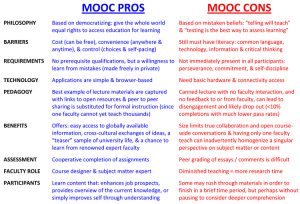Image source: Unsplash, Pixabay retrieved 2/12/2016
What is all the fuss about MOOCs?
There is no doubt that MOOCs are controversial and have both many pros and cons. MOOC’s are being touted as a ” disruptive innovation” to higher education, challenging the current and traditional models of higher education (Flynn, 2013). This challenge comes on several fronts which includes the provision of education that is freely available, scalable to facilitate massive enrolments, and views learning as a community process. cMOOCs are based around the theory of ‘connectivism’, a term coined by Siemens in 2005 that’ describes learning as a process of network formation, with connections being key to networked learning, while Downes (2009) asserts that knowledge consists of the network of connections formed from experience and interactions with a knowing community ‘ (Kellogg, Booth, Oliver, 2014, p.265). Connectivist courses (or cMOOCs) allow the learners to generate and create content together (Siemens, 2011).
There is a lot of debate around whether MOOCs will enhance or hinder universities with many academics fearing MOOCs and the impact they will have on such things as their intellectual property or even their futures within Universities.
Advantages and Disadvantages of MOOCs
Bilington and Fronmueller (2013) outline some of these scenarios as well as some of the advantages and disadvantages of MOOCs.
Massive numbers of enrolments
It is a positive factor that huge numbers are being exposed to a topic, and given a taster of the content for a university course. Disadvantages include difficulty in managing, assessing, facilitating interaction and supporting such huge numbers for those running the MOOCs, which often results in large numbers of participants disengaging, dropping out and not completing courses. So while tens of thousands of students may sign up for a MOOC, often less than 7% of them complete it.
It’s free and open to anyone, anywhere!
“The development of MOOCs is rooted within the ideals of openness in education, that knowledge should be shared freely, and the desire to learn should be met without demographic, economic and geographical constraints” (Yuan and Powell,2013, p.6). This ‘opening up of education ‘ through the use of technology provides new opportunities for those who were previously unable to access education, giving those who are disadvantaged, either by geography, social or financial circumstances, the opportunity to learn and engage in education.
The disadvantages to this: despite this ‘global approach’ to education the majority of courses come from an English language basis which may limit how accessible they are anyway.
Participants are usually white, from English-language countries, already educated ‘nevertheless, a survey completed in 2015 shows that those with low socioeconomic status from non-OECD countries and those without a college education are more likely to report benefits. The overwhelming majority of people who completed MOOCs report career or educational benefits, and a substantial number report tangible benefits such as getting a new job, starting a business, or completing prerequisites for an academic program’ (Zhengao, 2015).
The following chart illustrates some of the pros and cons of MOOCs:

Image source: http://simonpriest.altervista.org/VT.html
What does the future hold?
Sebastian Thrun made the bold statement that “job applicants will tout their Udacity degrees. In 50 years there will only be ten institutions in the world delivering higher education and Udacity has a shot at being one of them” (Krause, 2014,p.83). Things have not exactly panned out this way for Udacity but higher education institutions are exploring how they can use MOOCs platforms to run and deliver credited courses. The recent development of ‘Micro-Masters’ courses that are now being offered is an example of that.The number of institutions running MOOCs and the number and variety of MOOCs available is constantly growing and expanding. The question of MOOC survival and growth remains to be seen and how they will evolve into the future and contribute to the online education arena.
Further Resources
- MOOCs and open education: Implications for higher education
- Just out of interest here is a list of the 50 most popular MOOCs of all time: https://www.onlinecoursereport.com/the-50-most-popular-moocs-of-all-time/
- World Bank Group Open Learning Campus https://olc.worldbank.org/wbg-academy of community development courses
- Further thoughts from Peter Norvig who taught one of the first MOOCs along with Sebastian Thrun from Stanford University. https://www.ted.com/talks/peter_norvig_the_100_000_student_classroom
A few questions you can respond to
Use the forum to post your thoughts to some of the following questions.
- What are some of the advantages and disadvantages do you see in MOOCs ?
- Do you think MOOCs are a disruptive technology? In what ways?
- What might be the long term impacts or future of MOOCs?
- Do you think MOOCs will have a place in Higher education?
References:
Billington, P. J., & Fronmueller, M. P. (2013). MOOCs and the future of higher education. Journal of Higher Education Theory and Practice, 13(3), 36-43. Retrieved from http://search.proquest.com/docview/1500823170?accountid=8330
Flynn, J. T. (2013). MOOCS: DISRUPTIVE INNOVATION AND THE FUTURE OF HIGHER EDUCATION. Christian Education Journal, 10(1), 149-162. Retrieved from http://search.proquest.com/docview/1344056030?accountid=8330
Kellogg, S., Booth, S., & Oliver, K. (2014). A social network perspective on peer supported learning in MOOCs for educators. International Review of Research in Open and Distance Learning, 15(5),263-289.Retrieved from http://search.proquest.com/docview/1634290327?accountid=8330
Krause, S. D. (2014). Invasion of the MOOCs: The promises and perils of massive open online courses Parlor Press.
